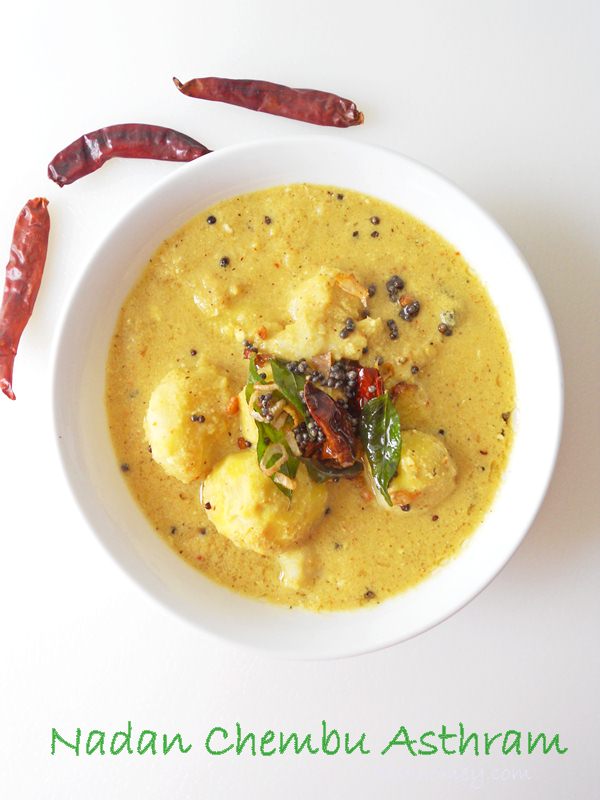Nadan Chembu Astharam, is a traditional Kerala style taro root curry made with coconut and curd (yogurt) and lastly seasoned with coconut oil. Typically nadan chembu (organic backyard taro root) is used, preferably smaller size (tender ones), though full grown bigger ones can be used, the baby ones (kochu chembu) are more tastier for astharam.
Chembu or taro is a common root vegetable found abundantly in Kerala. These curries are not so popular with the younger generation but the older generation simply love it. As I have mentioned earlier; I try to include traditional recipes as much as possible in our family meal and this is one such curry which I make whenever chembu is available.
This curry is most popular in my hometown Kottayam, I have not seen this in Malabar (North Kerala). I have memories of my grandmother making this curry as a child, which was passed on to my amma.....and after marriage, my MIL also makes the curry the same way....my son loves this very much and and hence I make it whenever taro is available.
Some traditional recipes I try to include in our meals are Chembu Ularthiyathu, Kachil Puzhungiyathu, Chena Mezhukkupuratti, and Unakka Kappa Curry (dried tapioca)
Do try to include traditional Kerala recipes in your diets.
Nadan Chembu Asthram, Taro Root Curry Recipe
PREP TIME: 10 Mins |
COOK TIME: 20 Mins |
SERVES: 3
INGREDIENTS
- Chembu/Taro Root: 1/2 kg
- Water: 3/4 to 1 cup.
- Turmeric Powder: 1/2 tsp.
- Kudam Puli: 1 small piece.
- Salt: 1/2 tsp or as needed.
- Curd/Yogurt: 3 tbsp.
- To Grind:
- Grated Coconut: 1/2 cup.
- Coriander Seeds: 1/2 tsp.
- Shallots or Cheriya Ulli: 7 to 8.
- Turmeric Powder: 1/2 tsp.
- Whole Kashmiri Chilli: 3 or 4.
- Water: 2-3 tbsp.
- To Season:
- Coconut Oil: 1 tbsp.
- Shallots: 3 or 4, sliced finely.
- Mustard Seeds: 1/2 tsp.
- Whole Kashmiri Chilli: 2, broken
- Curry leaves
METHOD:
- This is the Chembu (taro root) I was talking about, the tender ones are best for this curry.Scrape the skin and clean thoroughly under running water, cut in 1 inch.
- Put the cleaned taro in a pan/bowl, add water, turmeric, salt, and kudampuli. Allow it to come to a boil and simmer for 5 minutes or until it is cooked.
- While it is getting cooked, put everything under "to grind" in a chutney bowl.
- And grind to a fine paste with water.
- Add this into the cooked taro.....stir well....simmer the fire
- Add in the beaten curd/plain yogurt....mix.
- Lastly, heat a tadka pan with coconut oil, add in mustard seeds, shallots, whole red chilli, curry leaves and pour over the curry. Close the pan with a lid, so that the flavor does not get out.
- Serve hot with rice. One of the best dish to beat the monsoon blues.
©Copyright Reserved 2010-2014, Nisahomey.com









different type of curry very nice
ReplyDeleteyou have explained it so well. looks like our moru kootan or kalan.have never made anything using chembu .
ReplyDeletelooks inviting
Loved the look of the Keralan taro root curry. Wonderfully taken pics as well.
ReplyDeleteDeepa